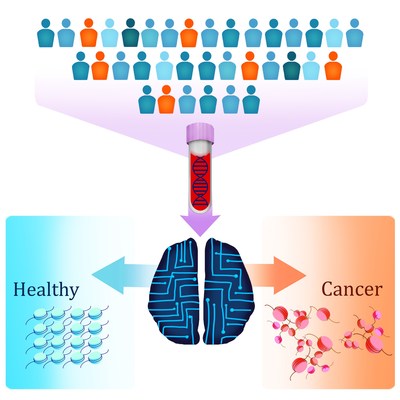BALTIMORE, May 29, 2019 /PRNewswire/ -- Researchers at the Johns Hopkins Kimmel Cancer Center say they have developed a simple, new blood test that can detect the presence of seven different types of cancer by spotting unique patterns in the fragmentation of DNA shed from cancer cells and circulating in the blood stream.

In an early proof-of-concept study, the test, called DELFI (DNA evaluation of fragments for early interception), accurately detected the presence of cancer DNA in 57% to more than 99% of blood samples from 208 patients with various stages of breast, colorectal, lung, ovarian, pancreatic, gastric, or bile duct cancers in the U.S., Denmark and the Netherlands.
DELFI also performed well in tests of blood samples from 215 healthy individuals, falsely identifying cancer in just four cases. The test uses machine learning, a type of artificial intelligence, to identify abnormal patterns of DNA fragments in the blood of patients with cancer. By studying these patterns, the investigators identified the cancers' tissue of origin in up to 75% of cases.
A report on the research published in the journal Nature.
Blood tests, or so-called "liquid biopsies" for cancer detection typically look for mutations, or changes in the DNA sequence within a cancer cell, or for methylation, a chemical reaction in which a methyl group is added to DNA, says senior study author Victor E. Velculescu, M.D., Ph.D., professor of oncology and co-director of the Cancer Biology Program at the Johns Hopkins Kimmel Cancer Center. But not all cancer patients have changes that are detectable using these methods and there is a great need for improved methods for early detection of cancer's genetic markers.
DELFI, he says, takes a different approach, studying the way DNA is packaged inside the nucleus of a cancer cell. It does so by looking in the blood at the size and amount of DNA from different regions across the genome for clues to that packaging.
Alessandro Leal, M.D., a Ph.D. candidate at the Johns Hopkins University School of Medicine, explains that the nuclei of healthy cells package DNA like a well-organized suitcase in which similar items are loaded together in separate sections. By contrast, the nuclei of cancer cells are more like disorganized suitcases, with items from across the genome thrown in haphazardly.
"For various reasons, a cancer genome is disorganized in the way it's packaged, which means that when cancer cells die they release their DNA in a chaotic manner into the bloodstream," says Jillian Phallen, Ph.D., a Johns Hopkins Kimmel Cancer Center postdoctoral fellow. By examining this cell-free DNA (cfDNA), the DELFI test helps identify the presence of cancer by detecting abnormalities in the size and amount of DNA in different regions of the genome based on how it is packaged."
The researchers caution that the test's potential must be further validated in additional studies, but if that happens it could be used to screen for cancer by taking a tube of blood from an individual, extracting the cfDNA, studying its genetic sequences, and determining the fragmentation profile of the cfDNA. The genome-wide fragmentation pattern from an individual can then be compared to "reference populations" with known cancer types to determine if the pattern is likely healthy or derived from cancer.
Robert B. Scharpf, Ph.D., associate professor of oncology at the Johns Hopkins University School of Medicine, says that because the genome-wide profile may reveal differences associated with specific tissues, these patterns, if found to be derived from cancer, can also indicate the source of the cancer, such as from the pancreas, breast, etc.
DELFI simultaneously analyzes millions of sequences from hundreds to thousands of regions in the genome, identifying tumor-specific abnormalities from minute cfDNA amounts, says Scharpf.
Using the DELFI test, investigators found that genome-wide cfDNA fragmentation profiles are different between cancer patients and healthy individuals. In cancer patients, fragmentation patterns in cfDNA appear to result from mixtures of DNA released from both blood and tumor cells, and show multiple distinct genomic differences with increases and decreases in fragment sizes at different regions.
DELFI detected cancer in 73% of cancer patients overall, while misclassifying four of 215 healthy individuals (98% specificity). The test also was found to be 61%-75% accurate in identifying the tissue of origin of the cfDNA, compared to current mutation-based cfDNA analyses. When both of these approaches were combined, investigators said they could accurately detect 91% of cancer patients.
The team is in the process of scaling up their analyses to study DELFI's ability in thousands of samples. "We're extremely encouraged about the potential of DELFI because it looks at a completely independent set of cancer DNA characteristics from those that have posed difficulties over the years," Velculescu says.
Photo - https://mma.prnewswire.com/media/893662/DELFI_picture.jpg


